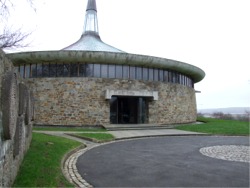RTE celebrates Burt
‘masterpiece’ 23.03.07
THE LATE Greencastle
architect Liam
McCormick created a “masterpiece” of Irish architecture
when he designed St. Aengus church in Burt.
That’s according to Co. Derry-born architect Sean
Harrington who travelled to Inishowen recently to do a
feature on the 40-year old chapel for RTE Radio
One’s ‘The Architect’s Eye’.
Starting out at Grianan of Aileach where, on a good
day, you can “see five counties”, Harrington outlined
the history of the seminal building that was designed by
McCormick between 1964 and 1965 and completed in 1967.
“It’s one of the few works of architecture in Ireland
you could truly call a masterpiece,” he explained.
“It encompasses the spirit of its age yet it’s timeless. That is a much overused word but when you see
(the church) you can see why it’s timeless.” |
Harrington, who is based in
Dublin, explained how McCormick, who practised in Derry,
created the building “in dialogue” with the ancient
ringfort further up the hill, achieving an organic
structure that “looks like it has grown out of the field
it is sitting in”.
“There is a real dialogue, a connection between the two
formally, in other words, they look like each other,
they are both stone circles,” he said.
McCormick, whose widow Joy still lives in Greencastle,
was commissioned by the Bishop of Derry around 1963 to
build a chapel for the local village. |
 |
He persuaded the bishop to
change the proposed location and built the church slightly out
of the village to avail of the most architecturally
advantageous and spiritual site.
The final location was sited next to the Presbyterian
Church to one side with the Church of Ireland on the
other.
Such a siting – in closer proximity to the ancient
ringfort – allowed him, says Harrington, “to make the
connection and turn it into a 20th Century masterpiece”.
The Portstewart-born architect, accompanied by ‘The
Architect’s Eye’ presenter Liam O’Brien, went on to
describe the beauty of both the exterior and interior of
the circular chapel, which was named Ireland’s ‘Building
of the 20th Century’ in the late 1990s. He praised the sweeping
copper-covered roof…almost like a tent that is draped
over the church and separated from the walls by a
horizontal band of glazing. “That is visually very
interesting, it disengages the roof from the walls so it
looks like it’s floating above. Inside the effect is
really beautiful.”
McCormick described St. Aengus as his ‘pagan church’
because of its close dialogue and referencing with the
ancient ringfort nearby. He collaborated with a number
of famous artists throughout 1965 and 1966 including
Oisin Kelly whose sculpture outside the front door marks
the history of the site. |
 |
The cobblestones used on
the outside were salvaged by McCormick from the Derry
docks when, during a renovation project, they were going
to be “thrown into the Foyle”.
“He put them to one side and then reused them in many
places within the church which was a great recycling of
materials,” said Harrington.
Moving inside the building, Harrington admired the off centre roof
light above the altar, the beautifully curved plastered
ceiling and the stunning stained glass designed in the
Cubist style by Helen Maloney.
He said the circularity of the church, with its
reference to the ‘circle of life’ made it equal all
around and all-inclusive, to give the congregation the
feeling they were in Mass together. |
He said this was an
interesting response by McCormick to Vatican II, which
was designed to encourage more participation on behalf
of the laity to church services.
And were the colours, shape and modernism of Burt chapel
a culture shock to the local community in the 1960s?
Harrington explains: “In an international sense it
captured the spirit of its time in 1965, 1966.
“One would imagine in this part of Donegal at the time
it was a culture shock, but interestingly, I don’t think
the church looks in the least bit dated. I think even if
it had been built last year you would think it was
remarkably modern on the one hand and also it would feel
comfortable.
“That essence of timelessness, is a rare achievement for
any architect or artist…designing something that is both
in the spirit of its age and also something that will
last forever…something that is appreciated by your
peers, by other architects, but also something that is
immediately appreciated by lay people, people who are
not architects.”
He added: “So to be able to capture that essence in
artwork, where something that is both contemporary and
timeless but has huge popular appeal and something that
is appreciated by other people in the field is a
remarkable achievement and it happens very rarely. Some
architects never achieve that. McCormick did in this
church really incredibly well.” |
|

